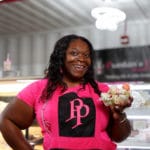The Amp Is Indy’s Newest Elevated Food Hall

FOURTEEN SHIPPING CONTAINERS, some painted bright turquoise, green, orange, and pink, are arranged in a colorful grid across the polished-concrete floor of a former service bay. Their corrugated exoskeletons bear cheery restaurant branding and hand-lettered menus. Their innards glow with refrigerated cases and tidy metal countertops. Retro pop music (think Billy Idol’s “Mony Mony”) bounces off the high ceiling, amplifying the buzzy Tibetan sound bath of food-court noises, as customers perched on metal stools eat their poke bowls and Buffalo Indy salads. Displayed prominently over an open steel container left empty for live entertainment, three gleaming capital letters remind everyone that they are spending their precious lunch hour at the AMP—a fittingly cool acronym for this “artisan marketplace” on the edge of IUPUI.
If you no more than squint in the direction of the concrete-block walls and steel support beams, you’ll see traces of the industrial space that was here before. The Indianapolis Water Company once used these cavernous 40,000 square feet as a garage. The floors were partitioned for service vehicles and left covered in deep pocks. “Over where we put in the bathrooms, they had a car wash,” says concept developer and general manager Craig Baker, nodding in the direction of an airport-style restroom suite that now resembles an industrial-chic boardroom.
The first time Baker walked into the gaping maw of this structure, he saw its potential. The chef and consultant who has opened 31 restaurants over the course of his career (most notably his own farm-to-bartop Local Eatery & Pub) pitched his concept to the AMP’s parent 16 Tech Innovation District team, incorporating the shipping containers into a design inspired by similarly grand projects like the Downtown Container Park in Las Vegas, an entire interconnected mall of shops, restaurants, bars, and entertainment venues. Baker’s idea involved arranging the containers in random blocks with their openings facing different directions. Visitors would have to roam around the building to take in the entire spread—to venture around corners and explore between the containers before deciding on a spot to stop for lunch. Baker wanted the place to feel less like an ergonomic shopping-mall food court—fast-food theater-in-the-round—and more like Mister Rogers’ Neighborhood, meandering and interactive. “When people come in, this forces them to engage with the entire space,” he says.

The pizza at Frankie’s Pizza Parlor.
It feels like Baker’s plan is working. After a quiet June opening, the AMP is in the first phase of its rollout and will eventually house more than 20 food vendors, including a full-service restaurant carved into one corner of the open-concept market. Hiatus Bar (run by the owners of Fountain Square’s Hi-Fi music venue) anchors the room. The draft list highlights lagers and ales from several local breweries, plus an Ash & Elm cider. Indy seafood legend Kathy Jones has claimed a spot for her Waterway Fish Market, an iced counter bejeweled with tuna, snapper, mussels, crab, and a variety of Hawaiian open-reef fish. She has a lead on some sweet Florida hogfish and has worked with the same Alaskan fisherman for six years, which guarantees a steady supply of salmon. Jones is also working with fellow vendor Andre’s BBQ & Seafood to offer a “you buy, we fry” collab.
In April, Turchetti’s Salumeria owner George Turkette set up the AMP’s first food counter, Frankie’s Pizza Parlor, selling jumbo New York–style slices. There are standard pepperoni and mushroom pizzas, but the crispy-crusted Capocollo Royale, topped with little blossoms of marbled Italian pork cold cut, pickled pineapple, and red onion, is an essential order. Pair it with soft, warm garlic knots dripping with locally made Chef Oya’s OG Garlic Trap Buttah and a salted-caramel milkshake.
Indy roaster Tinker Coffee runs a satellite cafe here, conveniently placed near the rows of pastries from Circle City Sweets, which relocated its baking operation from City Market to a performance kitchen just inside the main entrance. But many of the tenants are first-time restaurateurs, like Joanna Wilson of Punkin’s Pies, which deals in chocolate-dipped fruit rendered gem-like with edible glitter, and Boba & Everything owner Liza Christian. Hunter-gatherers hit the mother lode with PB&J Factory’s experiments in marshmallow fluff, Biscoff cookie butter, crushed nuts, and extra-chunky fruit jams. Yamallama Delicatessen offers elaborate grab-and-go items such as brunch biscuits and sandwiches pressed inside house focaccia. And the AMP will be the site of the Melon Kitchens restaurant accelerator, a ghost kitchen to help local Black chefs run successful businesses.
There will be onsite urban farming programs and space for growers to sell their goods. The goal is for the entire place to run almost self-sufficiently, like a village—an idea that might not have worked any other time than now, when restaurants battered by COVID-19 are poised for a fresh start, and diners have opened their hearts and their wallets to help.
- Chocolate-covered berries from Punkin’s Pies.
- The proprietor of Punkin’s Pies.









